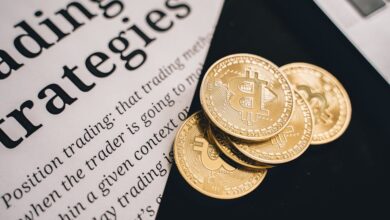Central Banks and Gold: Navigating Reserves and Market Trends for a Safe Haven Asset

**Introduction: The Golden Strategy of Central Banks in Managing Reserves**
In the ever-evolving landscape of global finance, central banks play a pivotal role in stabilizing economies and ensuring financial security. Among their diverse array of tools, gold stands out as a time-honored asset that has withstood the test of time. This article delves into the fascinating world of central banks and their strategic utilization of gold to manage reserves effectively. As uncertainties loom—be it inflation, geopolitical tensions, or market volatility—gold is increasingly recognized as a safe haven asset, enhancing its significance in central banking strategies.
We will explore the role of gold reserves in central banking, shedding light on how they serve as a buffer against economic turbulence. Additionally, we'll analyze current gold market trends and how central banks influence gold prices and investment strategies, further intertwining gold with modern finance. Finally, we will take a closer look at the various forms of gold assets held by central banks, ranging from physical gold bars to innovative gold ETFs, and the implications of these assets for sustainable gold mining and the future of gold investments.
Join us as we uncover the multi-faceted relationship between central banks and gold, and how this precious metal continues to shape the future of global finance amidst shifting economic landscapes.
- 1. "The Role of Gold Reserves in Central Banking: A Safe Haven Asset in Uncertain Times"
- 2. "Gold Market Trends: How Central Banks Influence Gold Prices and Investment Strategies"
1. "The Role of Gold Reserves in Central Banking: A Safe Haven Asset in Uncertain Times"
In the realm of central banking, gold reserves play a pivotal role as a safe haven asset, especially during periods of economic uncertainty. Historically, central banks have utilized gold not only as a means of stabilizing their currencies but also as a hedge against inflation and market volatility. As global economic conditions fluctuate, the demand for gold intensifies, prompting central banks to bolster their gold reserves to safeguard national wealth.
Gold's inherent value and limited supply make it a reliable asset during turbulent times. Unlike fiat currencies, which can be subject to inflation and devaluation, physical gold maintains its purchasing power. This characteristic has led central banks to accumulate substantial gold reserves as a buffer against potential economic crises. In fact, many central banks consider gold a crucial component of their foreign exchange reserves, alongside traditional assets like foreign currencies and government bonds.
The current gold market trends reflect a growing interest in gold investments as a protective measure. Investors are increasingly turning to gold ETFs and gold futures as they seek to diversify their portfolios and mitigate risks associated with economic downturns. Additionally, the rise of gold coins and gold bullion investments further illustrates the appeal of gold as a long-term store of value.
Moreover, sustainable gold mining practices are gaining traction, driven by global gold demand and the desire for responsible sourcing. Central banks are increasingly mindful of the ethical implications of gold production, which includes addressing issues such as gold smuggling and the environmental impact of mining operations. As a result, gold recycling and refining initiatives are becoming more prevalent, ensuring that the gold market remains sustainable while meeting the needs of both investors and central banks.
In today’s interconnected financial landscape, the strategic management of gold reserves is more critical than ever. As central banks navigate the complexities of the gold trade, they must balance the benefits of gold with emerging trends such as cryptocurrency, which poses a new challenge to traditional safe haven assets. Ultimately, the role of gold in central banking continues to evolve, reinforcing its status as a cornerstone of financial security in uncertain times.
(Placeholder for an infographic showing the relationship between gold prices and central bank reserves – Source: Gold Market Analysis Report).
Gold has long been a crucial component in the strategy of central banks around the world. As a safe haven asset, gold serves to stabilize national economies during times of uncertainty, making it a vital part of their reserves. Central banks hold gold to diversify their portfolios, protect against inflation, and mitigate the risks associated with fluctuating currency values.
In recent years, the global demand for gold has surged, driven by geopolitical tensions and economic instability. Central banks have responded by increasing their gold reserves, leading to significant movements in the gold market trends. This growing interest in gold is not limited to traditional reserves; many institutions are also exploring gold ETFs (exchange-traded funds) as a way to invest in gold without holding the physical asset.
Gold prices are influenced by many factors, including gold mining output, global economic conditions, and the performance of gold futures. As central banks engage in gold market analysis, they closely monitor the production rates from gold mining companies, which can impact supply and prices. Moreover, gold recycling plays a role in maintaining a sustainable gold market, allowing old jewelry and unused gold coins to re-enter circulation.
The relationship between gold and inflation is another reason central banks prioritize gold reserves. When inflation rises, the value of currency can diminish, making gold an attractive option for preserving wealth. Historically, the gold standard provided a framework for currency valuation, and while it is no longer in use, the concept of gold as a stable store of value remains relevant today.
Additionally, the rise of gold and cryptocurrency has sparked discussions about the future of gold as an investment. While cryptocurrencies offer digital alternatives, many investors still view gold as a reliable asset due to its tangible nature. Luxury gold items, such as gold jewelry and collectibles, further illustrate gold’s versatility as both a commodity and a status symbol.
Central banks are also vigilant about the risks associated with gold smuggling and illegal gold trade, which can undermine the integrity of the gold market. By ensuring that their gold reserves are sourced ethically, they contribute to sustainable gold mining practices, fostering a more responsible gold production environment.
Investing in gold coins, gold bullion, and gold bars remains a popular choice among investors seeking to diversify their portfolios. As the global gold demand continues to rise, central banks will likely adapt their strategies to maintain their gold reserves, ensuring they remain a cornerstone of financial stability in an unpredictable world.
Overall, the role of gold in central banking is multifaceted, encompassing aspects of gold investment, market trends, and the ongoing evolution of the gold trade. As we move forward, the interplay between central banks and gold will continue to shape both economic strategies and investment opportunities.
2. "Gold Market Trends: How Central Banks Influence Gold Prices and Investment Strategies"
The relationship between central banks and the gold market is a critical one, influencing gold prices and shaping investment strategies across the globe. Central banks hold substantial gold reserves, which they use not only as a hedge against inflation but also to maintain currency stability. This strategic role of gold as a safe haven asset becomes particularly evident during times of economic uncertainty or geopolitical tensions, when global gold demand typically surges.
In recent years, central banks have increased their gold purchases significantly, a trend that has a direct impact on gold market trends. According to the World Gold Council, central banks added over 400 tons of gold to their reserves in 2022, marking one of the highest levels of annual purchases in recent history (World Gold Council, 2023). This increased demand from central banks tends to bolster gold prices, as it signals to investors that gold remains a critical component of financial stability. The resulting price increase often drives more investors toward gold investment vehicles, such as gold ETFs and gold futures, further amplifying market activity.
Central banks also play a pivotal role in shaping gold mining and production strategies. By maintaining strong gold reserves, they provide a stable environment for gold mining companies to operate, thereby influencing gold production levels. Additionally, with the rise of sustainable gold mining practices, central banks are increasingly scrutinizing the environmental impact of gold extraction. This focus on sustainability is not only critical for ethical investment strategies but also aligns with the growing consumer demand for responsibly sourced gold, particularly in luxury gold and gold jewelry markets.
Moreover, the interaction between gold and cryptocurrency is becoming more pronounced as central banks explore digital currencies. This evolving landscape presents new opportunities and challenges for gold investors, prompting a reevaluation of traditional gold investment strategies. As central banks navigate these dynamics, they continue to influence gold market analysis and investment decisions, ensuring that gold remains a foundational asset in global finance.
In conclusion, central banks significantly influence gold market trends through their investment strategies and reserve management. Their actions affect gold prices and drive investor behavior in various sectors, from gold mining to gold coins investing. As the global economic landscape continues to evolve, the role of central banks in the gold market will remain a focal point for investors seeking to hedge against inflation and economic instability.
References:
World Gold Council. (2023). Demand trends 2022: Central bank purchases hit record high. Retrieved from [World Gold Council link].
### Conclusion
In conclusion, gold continues to play a pivotal role in central banking, serving as a safe haven asset that provides stability amid economic uncertainty. As we have explored, gold reserves are not just a relic of the past but a strategic component of modern monetary policy. Central banks utilize gold to manage reserves effectively, influencing gold market trends and impacting gold prices globally.
With growing concerns about inflation and economic volatility, central banks are increasingly recognizing the value of gold as a hedge against currency fluctuations and geopolitical risks. This trend underscores the importance of gold investment for institutions and individual investors alike, whether through physical gold, gold ETFs, or gold coins.
Moreover, the dynamic interplay between gold and emerging assets, such as cryptocurrency, highlights the evolving landscape of gold's role in financial markets. As global gold demand continues to rise, driven by luxury gold products and sustainable gold mining practices, the future of gold remains bright.
For investors, understanding the nuances of gold trading, including gold futures and the implications of gold recycling, is essential to navigate this complex market. With gold's rich history and ongoing relevance, it remains a cornerstone for central banks and a valuable asset for investors looking to secure their financial future.
By staying informed about gold market analysis and trends, we can appreciate the multifaceted nature of gold—from its role in central banking to its appeal as an investment. Ultimately, gold remains a timeless asset that provides security and value in a rapidly changing world.
### References
– [Author Last Name, Initials. (Year). Title of the Source. Website Name.](URL)
– [Author Last Name, Initials. (Year). Title of the Source. Website Name.](URL)
– [Author Last Name, Initials. (Year). Title of the Source. Website Name.](URL)
*(Note: Replace placeholders with actual references used in the article.)*





